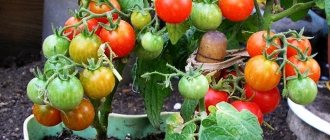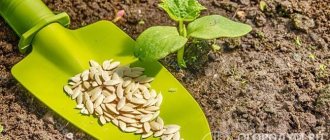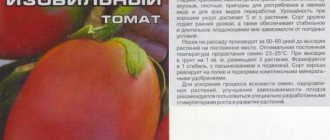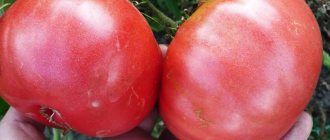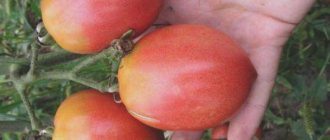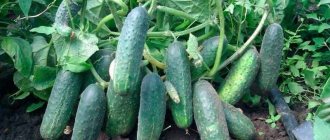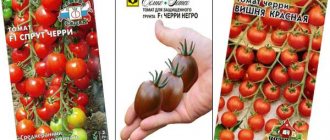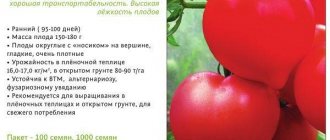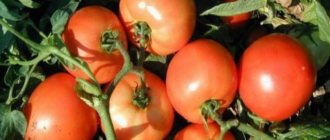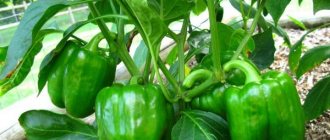Tomato “Mashenka”: description of the variety
| Variety name | Mashenka |
| general description | Mid-season indeterminate variety |
| Originator | Russia |
| Ripening period | 112-116 days |
| Form | Round, slightly flattened |
| Color | Red |
| Average weight of tomatoes | 210-260 grams |
| Application | Dining room |
| Productivity of the variety | 25-28 kg per sq.m |
| Features of cultivation | Standard agricultural technology |
| Disease resistance | Highly disease resistant |
The Mashenka tomato is a hybrid plant intended for both amateur greenhouses and open ground. There are no hybrids of the same name.
It belongs to the tall indeterminate varieties; the length of the shoots can reach 2 meters or more. It is not a standard bush. The tomato is mid-season, the fruits ripen 112–116 days after emergence.
One of the main advantages of the variety is its high resistance to many diseases characteristic of tomatoes. Mashenka is practically not affected by tobacco mosaic, fusarium, alternaria and late blight.
The yield of the variety is very high! From one bush you can collect from 5.5 to 12 kg . The average yield per square meter of planting is 25–28 kg.
You can compare the yield of this variety with others in the table below:
| Variety name | Productivity |
| Mashenka | 25-28 kg per sq.m |
| Nastenka | 10-12 per square meter |
| Gulliver | 7 kg per bush |
| Lady Shady | 7.5 kg per square meter |
| Honey Heart | 8.5 kg per square meter |
| Fat Jack | 5-6 kg per bush |
| Doll | 8-9 kg per square meter |
| Summer resident | 4 kg per bush |
| Lazy | 15 kg per square meter |
| The president | 7-9 kg per square meter |
| King of the market | 10-12 kg per square meter |
Read on our website: how to get a large harvest of tomatoes in open ground? How to grow a lot of delicious tomatoes all year round in greenhouses? What are the subtleties of agricultural technology for early varieties?
Harvesting
The beginning of the harvest depends on the consumer purpose of the fruit. If tomatoes are grown for raw consumption, they are removed from the plant when they reach full ripeness. Such fruits acquire a rich red color and are easily separated from the stalk. If transportation is necessary, the crop is extracted in the blanching phase. These tomatoes have a slight reddish-green tint to the skin, which intensifies in the stalk area.
Sometimes the fruits are cut green, in the so-called green-ripening phase. Such tomatoes have fully formed size, structure and seeds, but their color is predominantly green or pale green, without any reddish or brown inclusions. This crop is usually harvested for long-term storage (2–3 months). This helps extend the shelf life of fresh tomatoes until late autumn.
Find out how to properly store tomatoes at home.
Tomatoes of the Mashenka variety are considered one of the main assets of modern selection of highly productive varieties of fruit crops. This plant is characterized by high productivity and resistance to all kinds of diseases. But in order for a crop to produce truly high-quality fruits, it must be provided with proper care.
Advantages and disadvantages
Pros:
- very good yield;
- delicious sweet and sour fruits with a characteristic aroma;
- tolerant to hot and cold temperatures;
- resistant to a number of diseases.
The main disadvantage is that it requires pinching and tying up.
Reviews from gardeners
Natalya, 39 years old, Zelenograd
I have been cultivating this variety at my dacha for several years. It has the following advantages: unpretentious, high yield, excellent presentation. I like that the seeds from ripened vegetables can be reused.
Nikolay, 55 years old, Vladimir
I grew this tomato in a greenhouse, planted it, and everyone in the house likes it. We make juices and ketchups from the fruits, put some in the basement, and sell the excess on the market.
Elena, 43 years old, Krasnodar
Fruit characteristics
- Mashenka’s fruits are very large, even gigantic, round in shape, flattened at the top and bottom.
- Average weight - 210–260g, maximum - 630g.
- The coloring is even, monochromatic, deep red.
- There is no green spot near the peduncle; there are no inclusions.
- There can be 4 or 6 cameras.
- Dry matter is about 4.8–5.1%.
- Sugars 4–4.2%.
- The fruits do not last very long - only 2-3 weeks.
Mostly salad due to the large size of the fruits, which simply will not fit through the neck of the jar. Also used to make juice, sauce and paste. The fruits are distinguished by very friendly, almost simultaneous ripening.
You can compare the weight of fruits with other varieties in the table below:
| Variety name | Fruit weight |
| Mashenka | 210-260 grams |
| Bobcat | 180-240 |
| Russian size | 650-2000 |
| Podsinsky miracle | 150-300 |
| American ribbed | 300-600 |
| Rocket | 50-60 |
| Altaic | 50-300 |
| Yusupovsky | 500-600 |
| Premier | 120-180 |
| Honey Heart | 120-140 |
Features of cultivation
Tomato Mashenka is suitable for the Central and Central Black Earth, North Caucasus regions, as well as the Urals, Volga region, Western and Eastern Siberia.
To obtain seedlings, it is recommended to sow seeds in March, the deadline is early April. Before planting in a permanent place, the seedlings are fed 2 or 3 times with a special complex for seedlings.
It can be transplanted into open ground in the third ten days of May or the first ten days of June. Planting should be done according to the 65x45 cm pattern.
Important! It is better to form a bush into one shoot, cutting off all the stepsons. It must be tied to a vertical or horizontal support so that the stem does not break under the weight of the fruit.
Watering and fertilizing are carried out according to the standard scheme. When 4–6 bunches of fruit form on the shoot, the top needs to be pinched to stop further growth.
Read useful articles about fertilizers for tomatoes:
- Organic, mineral, phosphorus, complex and ready-made fertilizers for seedlings and the TOP best.
- Yeast, iodine, ammonia, hydrogen peroxide, ash, boric acid.
- What is foliar feeding and when picking, how to carry it out.
Care
To grow a high-quality crop, you will need to provide the crop with care. Watering should be frequent. For each young bush, 2 liters of warm water are consumed at intervals of 7 days. Adult plants need to receive more moisture, so the optimal volume of liquid for them is 5-6 liters.
After this procedure, the top layer of soil is loosened to a depth of 5 cm.
Timely removal of weeds will provide reliable protection against pests and diseases.
The planting of the Mashenka tomato is carried out in early July. To do this, remove all shoots that stand out from the total mass. Pinch the bushes at the end of summer at ovary level 8. This will stop their growth and direct beneficial substances to the formation of fruits and improve their taste. It is better to form bushes with 2 stems so that the tomatoes grow large.
Feeding is a necessary stage of care.
- At the beginning of summer, the beds are fed with saltpeter (100 g per 5 l). This will improve the formation of bushes and increase the yield.
- In mid-summer, potassium is used (20-30 grams per 5 l), which is necessary for the formation of large fruits.
- In September, water the tomatoes with superphosphate (25-30 g per 10 l). This is necessary to protect the roots from frost.
Organic substances cannot be used. They provoke premature evaporation of moisture and increase the risk of burns to the plant. If mineral components are used, at least 5 liters of fertilizer is poured under each bush.
Organic fertilizers are an essential component when preparing the soil for tomatoes, because... these plants place increased demands on soil fertility. Rotted manure and compost are added in the fall in the amount of 8-10 kg per 1 square meter. meter. The soil is immediately dug up with organic matter added.
Pests and diseases
The Mashenka variety is practically not affected by any diseases, due to its high resistance to them.
Among the harmful insects, aphids can attack. To get rid of it, you can use insecticides such as Iskra M, Decis Profi, Confidor, Aktara, Fufanon, Actellik.
No less harm can be caused by cutworm caterpillars. They actively eat leaves and reproduce very quickly. Chemicals such as Confidor, Coragen, Fastak and Proteus will help eliminate the threat. You can catch adult butterflies using pheromone traps.
The Mashenka tomato variety is high-yielding and unpretentious. It does not suffer from temperature changes, diseases and various stresses, so it is suitable even for novice farmers and gardeners.
How to tie up bushes
In a greenhouse, tying up tall bushes is easy - usually ropes are stretched from above, along which the plants then climb. But in open ground, it is often necessary to construct special devices for gartering.
Bushes can also be tied to pegs, but in this case you will need very long sticks - about 2 m in height each. The main thing is that you will need a lot of such sticks - a peg for each bush. You need to tie it with soft ropes or tear an old sheet into narrow strips. It is better to boil the fabric first so that it is sterile.
See also
Description of the Super Exotic tomato and rules for growing striped tomatoes
Read
Using a trellis, tying up tall tomatoes is easier and more effective. The stakes, approximately 2 m high, need to be driven in at a distance of 4 m from each other. A wire is stretched between them, connecting the upper points. And long fabric ropes are already tied to it, along which the tomatoes will subsequently curl. Do not pull the rope too tightly, as during cultivation you will squeeze the stem and damage the bush.
There is another option for tying to a trellis. The stakes, as in the previous example, are installed at a distance of 4 m from each other. Several rows of wire are stretched between them at intervals of about 70 cm. Fabric ropes are stretched across at more frequent intervals (about 30 cm). In this way, a grid is constructed along which the bushes will subsequently curl.
Video
We invite you to familiarize yourself with other productive tomato varieties in the following video:
In the table below you will find links to articles about tomatoes with different ripening periods:
| Mid-season | Late ripening | Super early |
| Nikitich | Premier | Alpha |
| Funtik F1 | Grapefruit | Pink Impression |
| Crimson Sunset F1 | De Barao the Giant | Golden stream |
| Sunrise F1 | Yusupovsky | The Lazy Man's Miracle |
| Mikado | Bull's heart | Pickling miracle |
| Azure Giant F1 | Rocket | Sanka |
| Uncle Styopa | Altaic | Locomotive |
Advice from experienced gardeners
Due to the wide distribution of the variety, numerous reviews from gardeners about Mashenka tomatoes have been collected. They allow you to highlight strengths and weaknesses, as well as collect a number of tips from those who have already grown it.
- In greenhouse and open ground conditions, yields differ between varieties from the same manufacturer. The best results were obtained when grown indoors.
- The plant is formed into 1-2 stems. No more than 5 brushes are left on the bushes. This is necessary to prevent the stem from breaking.
- The bushes require pinching and staking. Plants need support throughout their growth and during fruit ripening.
Every housewife who has already planted Mashenka tomatoes and tasted them returns again to this variety. The main advantage is the ability to collect seeds from the harvest and re-sow them next year.
